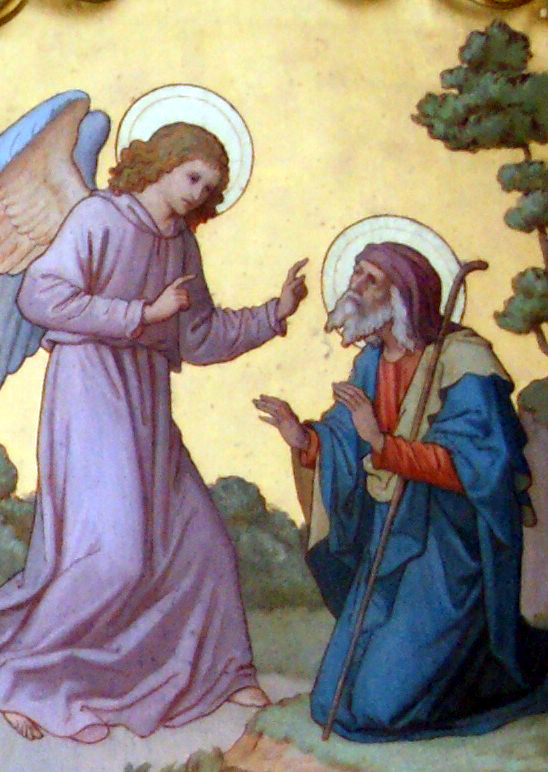

From time immemorial the Greeks have celebrated the Feast of St. Joachim on the day following Our Lady's Nativity. The Maronites kept it on the day after the Presentation in November, and the Armenians on the Tuesday after the Octave of the Assumption of the Mother of God. The Latin Church at first did not keep his Feast. Later on it was admitted and celebrated sometimes on the day after the Octave of Our Lady's Nativity, September 16, sometimes on the day following the Immaculate Conception, December 9. Thus both East and West agreed in associating St. Joachim with his illustrious Daughter when they wished to do him honor.
About the year 1510, Pope Julius II placed the Feast of the Grandfather of the Messias upon the Roman Calendar with the rank of double major; and remembering that family, in which the ties of nature and of grace were in such perfect harmony, he fixed the solemnity on March 20, the day after that of his Son-in-law, St. Joseph. The life of the glorious Patriarch resembled those of the first fathers of the Hebrew people; and it seemed as though he were destined to imitate their wanderings also, by continually changing his place upon the liturgical cycle.
Hardly 50 years after the Pontificate of Julius II the critical spirit of the day (the Protestant revolution) cast doubts upon the history of St. Joachim, and his name was erased from the Roman breviary. Pope Gregory XV, however, re-established his Feast in 1622 as a double, and the Church has since continued to celebrate it. Devotion to Our Lady's Father continuing to increase very much, the Holy See was petitioned to make his Feast a holyday of obligation, as it had already made that of his Spouse, St. Anne. In order to satisfy the devotion of the people without increasing the number of days of obligation, Pope Clement XII in 1738 transferred the Feast of St. Joachim to the Sunday after the Assumption of his Daughter, the Blessed Virgin Mary, and restored to it the rank of double major.
On August 1, 1879, the Sovereign Pontiff Leo XIII, who received the name of Joachim in Baptism, raised both the Feast of his glorious Patron and that of St. Anne to the rank of double of the second class.
The following is an extract from the decree Urbi et Orbi, announcing this decision with regard to the said Feasts: "Ecclesiasticus teaches us that we ought to praise our fathers in their generation; what great honor and veneration ought we then to render to St. Joachim and St. Anne, who begot the Immaculate Virgin Mother of God, and are on that account more glorious than all others."
"By your fruits are you known," says St. John Damascene; "you have given birth to a Daughter who is far greater than the angels and Who has become their glorious Queen." Now since, through the Divine Mercy, in our unhappy times the honor and devotion paid to the Blessed Virgin requires an increase in proportion to the increasing needs of the true Catholic people, it is only right that the glory which surrounds their Blessed Daughter should redound upon Her happy parents. May this increase of devotion towards them cause the Church to experience still more their powerful protection.
It may be wondered why the Gospel for the Mass of this Feast is that of St. Matthew's genealogy of Our Lord Jesus Christ, in which no mention is made of St. Joachim. The Gospel ends with the words: ...and Jacob begot Joseph, the spouse of Mary, of whom was born Jesus; Who is called Christ. "Rejoice, O Joachim, for of thy Daughter a Son is born to us," exclaims St. John Damascene. It is in this spirit the Church reads to us today the list of the royal ancestors of Our Savior. St. Joseph, the descendant of these illustrious princes, inherited their rights and passed them on to Jesus, Who was his Son according to the Jewish law, though according to nature He was of the line of His Virgin Mother alone.
St. Luke, Mary's Evangelist, has preserved the names of the direct ancestors of the Mother of the Man-God, springing from David in the person of Nathan, Solomon's brother. St. Joseph, the son of Jacob, according to St. Matthew, appears in St. Luke as son of Heli. The reason is, that by espousing Mary, Who was the only Daughter of Heli or Heliachim, that is Joachim, St. Joseph became legally St. Joachim's son and heir.
This is the generally accepted explanation of the two genealogies of Our Lord Jesus Christ. It is not surprising that Rome, the royal city who has become the Bride of the Son of Man in the place of the repudiated Sion, prefers to use in Her liturgy the genealogy which by its long line of royal ancestors emphasizes the Kingship of the Spouse over Jerusalem. The name of Joachim, which signifies "the preparation of the Lord," is thus rendered more majestic, without losing aught of its mystical meaning. He is himself crowned with wonderful glory. Jesus, his Grandson, gives him a share in His own authority over every creature.
Contact us: smr@salvemariaregina.info
Visit also: www.marienfried.com